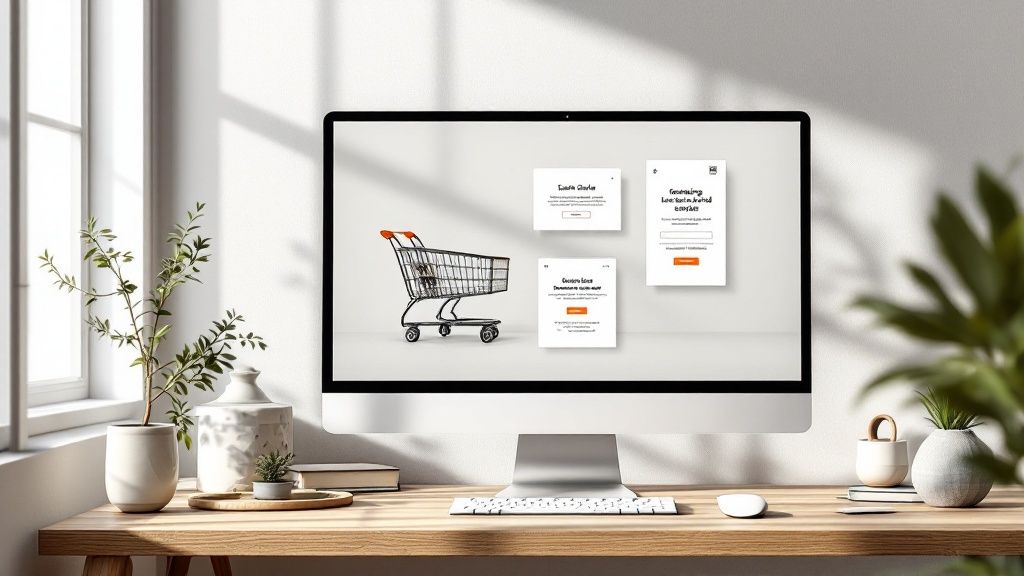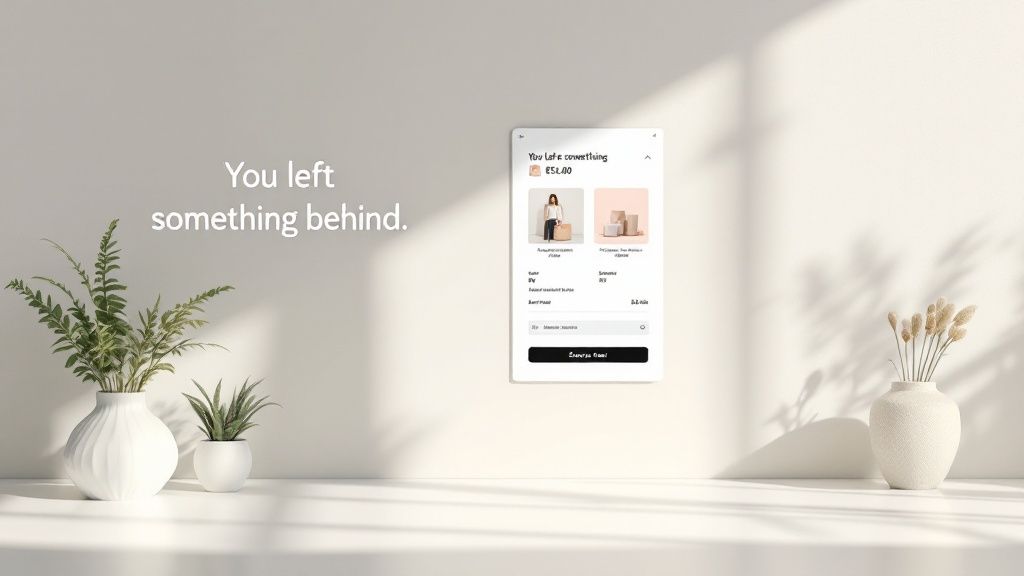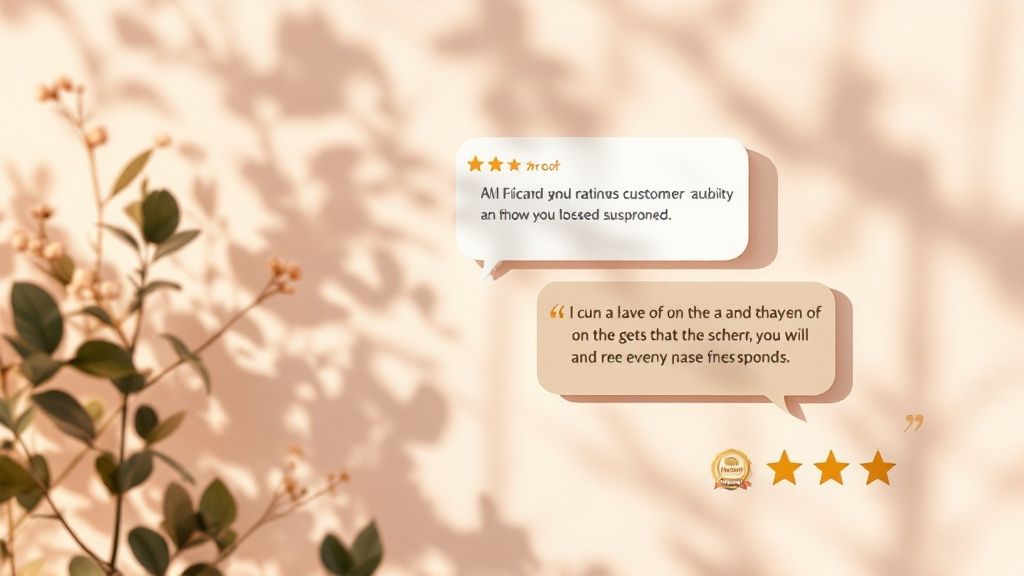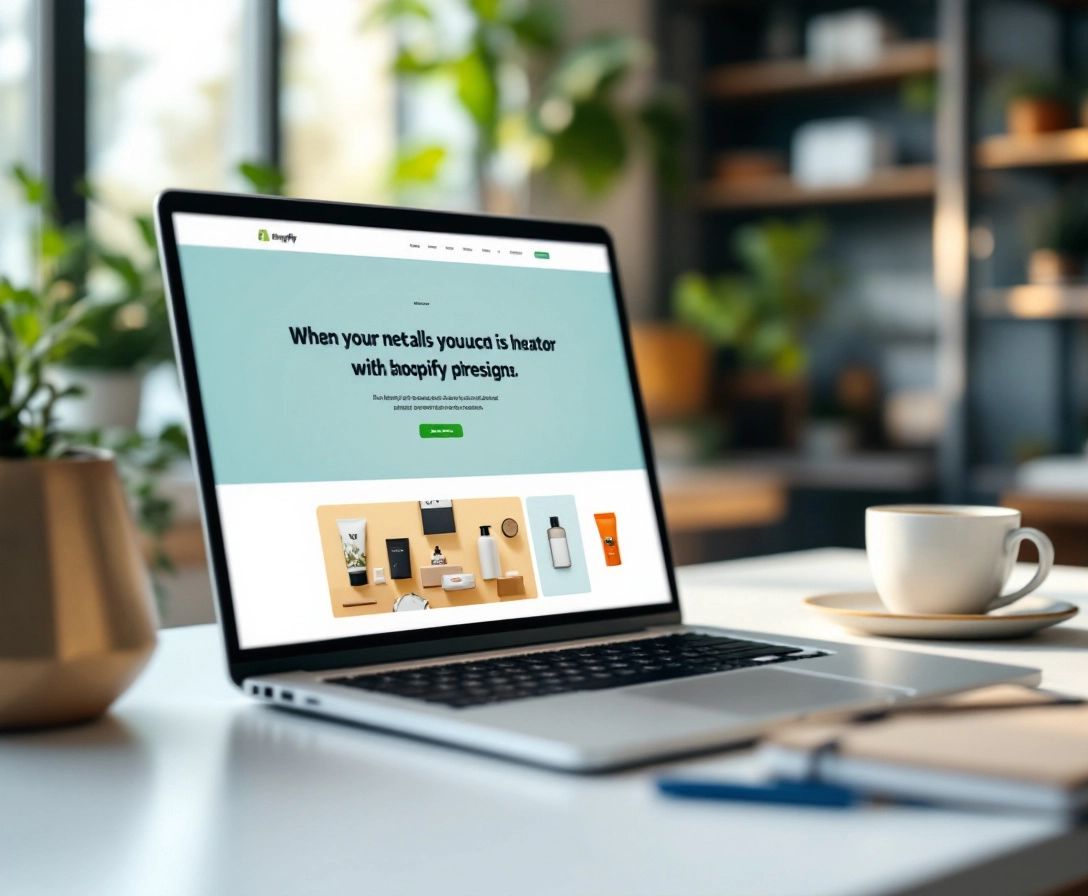8 Abandoned Cart Email Templates to Win Back Sales
March 20, 2025

Reclaim Lost Sales With Powerful Email Templates
Abandoned carts. These two words can make any ecommerce professional uneasy. They represent lost revenue, missed opportunities, and the frustrating reality that some customers get incredibly close to purchasing and then disappear. Minimizing cart abandonment is crucial for maximizing profitability for Shopify Shopify store owners, ecommerce managers, and Shopify Plus brands. But what if you could recover a significant chunk of those lost sales? You can, with well-crafted abandoned cart email templates.
Recovering lost sales has been an ongoing process since the beginning of ecommerce. Initially, simple reminder emails were the standard. However, as consumer behavior and email marketing became more sophisticated, so did the need for more persuasive and personalized communication. Today, effective abandoned cart emails use a combination of psychology, marketing best practices, and data-driven insights to subtly encourage customers to complete their purchases.
What makes these approaches successful? A deep understanding of customer motivations, along with compelling messaging and targeted offers.
Crafting High-Converting Emails
This article explores the art and science of crafting high-converting abandoned cart email templates. We'll examine proven strategies, from basic reminders to multi-stage sequences, incorporating elements like social proof, personalized storytelling, and even humor.
- Straightforward Reminders: Sometimes a gentle nudge is all it takes. A simple reminder email can be surprisingly effective, especially if sent within an hour of cart abandonment.
- Multi-Stage Sequences: For customers who don't respond to the initial reminder, a series of emails can be more impactful. These emails can offer increasing incentives, such as free shipping or a small discount.
- Social Proof: Highlighting positive reviews or testimonials can build trust and encourage hesitant customers to complete their purchase.
- Personalized Storytelling: Connecting with customers on a personal level can make your brand more relatable and increase engagement. Consider sharing customer stories or anecdotes that resonate with your target audience.
- Humor: Used appropriately, humor can be a powerful tool for re-engaging customers and making your brand memorable.
By the end of this article, you'll be able to create a set of effective email templates that will not only recover lost sales but also improve customer engagement and build brand loyalty.
1. The Straightforward Reminder
The Straightforward Reminder forms the basis of any abandoned cart email strategy. It acts as a gentle nudge, reminding customers about the items they left behind without overwhelming them with marketing. This approach focuses on a clean, simple design and a clear call to action. It's a highly effective first step in recovering lost sales. Its power lies in its simplicity: show the cart contents, remind the customer of their purchase intention, and simplify the checkout process.

This template typically includes clear product images, accurate pricing, and a single prominent "Complete Your Order" or "Return to Cart" button. It also provides a summarized view of the cart contents. A direct link back to the checkout removes any obstacles in the customer's path to purchase. Examples of this in action include Amazon's "You left something in your cart" emails, Wayfair's minimal cart reminder emails, and Target's simple cart reminders displaying product images. These companies use the Straightforward Reminder to recapture potential lost revenue.
Features of a Straightforward Reminder
- Simple, clean design
- Clear product images and pricing
- Single, prominent CTA button
- Cart contents summary
- Direct link back to checkout
Pros of Using This Strategy
- High conversion rate due to simplicity: The streamlined approach minimizes distractions, helping the customer focus on completing their purchase.
- Quick to implement: This template is easy to set up and requires minimal design work.
- Works well across all devices: The clean design ensures consistent display on desktops, tablets, and smartphones.
- Low risk of email client rendering issues: Its simplicity reduces the likelihood of display problems across various email providers.
Cons to Consider
- Lacks personalization elements: This template doesn't use personalized recommendations or customer data.
- May not stand out in crowded inboxes: Its minimalist design might not grab attention among visually compelling marketing emails.
- Limited opportunity for brand storytelling: The focus on functionality leaves little room for engaging brand narratives.
Tips for Implementation
- Timing is key: Send the email within 1-2 hours of cart abandonment for the best results.
- Accuracy matters: Show the exact items left in the cart with current pricing.
- CTA optimization: Use a large, contrasting color for the CTA button to make it stand out.
- Concise subject lines: Keep subject lines short, direct, and action-oriented (e.g., "You left something behind," "Complete your order").
The Straightforward Reminder, used by companies like Amazon and integrated into default templates for platforms like Shopify and WooCommerce, is a staple in e-commerce. Its effectiveness and ease of use make it a vital tool for any online retailer. For more information, check out our guide on abandoned cart emails for Shopify. This fundamental approach creates a solid foundation for building more complex abandoned cart email strategies, securing its place as the first entry on our list.
2. The Discount Incentive Template

The Discount Incentive Template is a cornerstone of abandoned cart recovery. It directly addresses price sensitivity, a common reason for cart abandonment. By offering a limited-time discount or special offer, this template entices customers to return and complete their purchase.
This template combines a sense of urgency with the perception of added value. This makes it particularly effective in competitive markets or when targeting budget-conscious shoppers.
Its popularity has grown with platforms like Klaviyo and the rise of Shopify Plus merchants, especially in fashion. Brands like H&M and ASOS have used time-limited discounts to recapture lost sales, contributing to this strategy's widespread adoption. Email marketing platforms streamline the process with pre-built templates and automated workflows.
Key Features and Benefits
- Prominent Discount Code or Offer: The discount is front and center, immediately grabbing attention.
- Countdown Timer or Expiration Date: Reinforces urgency and encourages immediate action.
- Cart Contents with Original and Discounted Prices: Clearly shows the price difference, adding perceived value.
- Urgency-Creating Language: Phrases like "Don't miss out" and "Limited time offer" incentivize quick action.
- Value Proposition Reinforcement: The email reminds customers why they were initially interested in the product.
Pros
- Higher Conversion Rates: Discount offers significantly boost abandoned cart recovery compared to non-incentive emails.
- Creates Immediate Action Through Urgency: Time-sensitive offers motivate quick purchases.
- Addresses Price Sensitivity: Directly tackles a major cause of cart abandonment.
- Measurable ROI Through Discount Code Tracking: Unique codes allow for precise tracking of effectiveness.
Cons
- Potential for Discount Dependency: Customers might intentionally abandon carts, expecting a discount.
- Impact on Profit Margins: Discounts reduce profit per sale.
- Brand Perception Concerns (Luxury Brands): Frequent discounts can devalue a luxury brand’s image.
- Sales Cannibalization Risk: Poorly timed discounts can impact full-price sales.
Real-World Examples
- Adidas: Offers 15% off to complete a purchase.
- Sephora: Uses "We saved your bag + 10% off" emails.
- ASOS: Employs time-limited discount offers on abandoned products.
Tips for Implementation
- Strategic Sequencing: Use discount incentives for the second or third email in your abandoned cart sequence.
- Unique Discount Codes: Use unique codes for accurate performance tracking.
- Reasonable Expiration Times: Set expiration times between 24-48 hours to create urgency.
- Optimized Discount Amounts: Test different amounts (e.g., 5%, 10%, 15%) to find the optimal balance.
- Alternative Incentives: Consider free shipping instead of discounts, especially for higher-value carts.
By understanding the Discount Incentive Template and these best practices, Shopify store owners and e-commerce managers can recover lost sales and boost revenue. Used strategically, it's a valuable tool for abandoned cart recovery.
3. The Social Proof Template
The Social Proof Template uses the psychological principle of social proof: people are influenced by the actions of others. When applied to abandoned cart emails, this means showcasing positive reviews, ratings, bestseller status, or even customer photos of the abandoned products. This encourages potential buyers to complete their purchase and directly addresses any trust or quality concerns that might have led to the cart abandonment.

Features
Here are some key features of the Social Proof Template:
- Product Ratings and Star Reviews: Displaying average star ratings and the total number of reviews gives a quick overview of customer satisfaction.
- Customer Testimonials: Including testimonials specific to the abandoned products adds a personal touch.
- User-Generated Content: Authentic customer photos and videos provide visual proof of product quality and use.
- Popularity Indicators: "Bestseller" or "Customer Favorite" labels create a sense of desirability and fear of missing out.
- Trust Badges and Guarantees: Security badges, money-back guarantees, and clear return policies can reduce purchase anxiety.
Pros and Cons
Like any strategy, the Social Proof Template has both advantages and disadvantages:
Pros:
- Builds Credibility: Social proof reassures potential customers about their purchase decision.
- Addresses Quality Concerns: It reinforces product value without relying on discounts.
- Creates FOMO: Highlighting product popularity encourages quick purchases.
- Maintains Brand Positioning: Avoids devaluing products through unnecessary price reductions.
Cons:
- Requires Existing Content: It depends on having a good amount of positive reviews and user-generated content.
- Automation Complexity: Dynamically inserting product-specific reviews can be technically challenging.
- Less Effective for New Products: Newer products with limited reviews may not benefit as much.
Examples of Effective Use
Several companies successfully use social proof in their abandoned cart emails:
- Casper: Uses snippets of 5-star reviews focusing on comfort and sleep quality.
- Allbirds: Highlights customer quotes about comfort and sustainability.
- Glossier: Leverages user-generated before/after photos showcasing product effectiveness.
Tips for Implementation
To maximize the effectiveness of this template, consider these tips:
- Relevance: Feature the most compelling and product-specific reviews.
- Credibility: Include exact review counts (e.g., "4.8 stars based on 1,245 reviews").
- Press Mentions: Add "as seen in" media logos or quotes for added credibility.
- Urgency: Show how many others have recently purchased the product.
- Reduce Risk: Highlight guarantees and return policies.
Evolution and Popularity
The Social Proof Template became especially popular with the rise of direct-to-consumer (DTC) brands like Warby Parker and Casper. These brands focused on building online trust and community, making social proof central to their marketing. Platforms like Yotpo further simplified incorporating customer reviews and user-generated content into email marketing.
This template is a valuable, non-discount strategy for recovering abandoned carts. For Shopify store owners, e-commerce managers, Shopify Plus brands, and email marketers, using social proof can improve conversion rates and revenue without compromising brand integrity or profit margins. It's a powerful way to convert hesitant shoppers into paying customers.
4. The Product Recommendation Template
The Product Recommendation Template offers a smarter approach to abandoned cart emails. It goes beyond simple reminders and dives into personalized upselling and cross-selling. Instead of just showing the abandoned items, this template uses browsing history, purchase patterns, and AI-powered recommendations to suggest alternative or complementary products. This is especially helpful when customers abandon carts due to product indecision, fit concerns, or general browsing.
This template earns its spot on the list because it turns a recovery email into a discovery opportunity. It recognizes that the initial items might not have been the right fit and provides a curated selection of alternatives to encourage a purchase. This can significantly boost average order value and introduce customers to products they may have otherwise missed.
Key Features
- Abandoned cart items section: The original cart contents are still clearly displayed, serving as the email's anchor.
- AI-powered product recommendations: This uses algorithms to suggest items based on individual customer behavior and preferences.
- "Customers also bought" section: This uses social proof by showcasing popular pairings with the abandoned items or similar products.
- Category alternatives: Offers different options within the same category, addressing potential fit/style concerns.
- Personalized product matching: Suggests items based on previously viewed or purchased products.
Pros
- Creates additional purchase opportunities: Goes beyond the initial cart items, increasing revenue potential.
- Addresses potential fit/style concerns: Offers alternatives that might better suit the customer's needs.
- Higher average order value potential: Encourages customers to add more items to their order.
- Provides additional discovery value to customers: Introduces new products they might be interested in.
Cons
- More complex to implement technically: Requires integration with a recommendation engine or robust product tagging.
- Can distract from primary cart recovery goal: Too many recommendations can shift focus away from the original items.
- Requires robust recommendation engine or product tagging: The effectiveness relies on the quality of the recommendations.
- May overwhelm if too many options are presented: A cluttered email can deter customers.
Real-World Examples
- Nordstrom's "You might also like" abandoned cart emails: Nordstrom effectively integrates personalized product recommendations alongside abandoned cart items, offering stylish alternatives.
- Sephora's product recommendation matrix in recovery emails: Sephora uses a visually appealing grid layout to present complementary beauty products, enhancing the customer experience.
- Booking.com's suggesting alternative properties or dates: Booking.com addresses potential booking hesitations by suggesting different properties or travel dates.
Tips for Implementation
- Limit recommendations to 3-5 highly relevant items: Avoid overwhelming the customer with too many choices.
- Place cart items prominently above recommendations: Maintain focus on the primary recovery goal.
- Consider showing bestsellers if personalized recommendations aren't available: Provides a fallback option when personalized data is limited.
- Test showing complementary items vs. alternative options: Determine which approach yields better results for your target audience.
- Ensure mobile-responsive design for recommendation grids: Optimize the email for viewing on different devices.
Popularized By
The Product Recommendation Template has gained popularity thanks to advancements in recommendation engines and predictive analytics. Enterprise retailers with advanced data capabilities, platforms like Klaviyo with built-in predictive analytics features, and giants like Amazon with their highly refined recommendation algorithms have all contributed to its widespread use. This template has grown from a simple cross-selling tactic to a personalized experience that anticipates customer needs and improves the online shopping journey for Shopify store owners, e-commerce managers, Shopify Plus brands, and email marketers.
5. The Problem-Solving FAQ Template
This template proactively addresses cart abandonment by tackling common customer hesitations. Instead of just showing abandoned items, it anticipates potential roadblocks in the buying process and provides immediate answers. By preemptively addressing FAQs about shipping costs, return policies, product specifics (like sizing or compatibility), and payment security, this email aims to eliminate friction, build confidence, and encourage checkout completion.
This approach recognizes that cart abandonment isn't always about price or forgetfulness. Customers might hesitate due to uncertainty or unanswered questions. This template directly addresses those concerns. For example, if a customer abandons a cart with shoes because they are unsure about sizing, the email would proactively highlight the brand's sizing chart, fit guide, and return policy.
Features
-
Direct Answers to Common Purchasing Concerns: This is the core of the template, presenting FAQs clearly and concisely.
-
Shipping and Delivery Information: Details on shipping costs, estimated delivery times, and tracking options are readily available.
-
Return and Exchange Policy Highlights: Clear explanations of the return process, timelines, and any associated costs build trust and reduce purchase anxiety.
-
Payment Options and Security Assurances: Listing accepted payment methods and highlighting security measures can alleviate concerns about online transactions.
-
Customer Service Contact Options: Providing easy access to support through email, phone, or live chat encourages customers to reach out with any remaining questions.
Pros
-
Directly Addresses Specific Abandonment Reasons: By targeting specific concerns, this template is more likely to resonate with hesitant customers.
-
Builds Trust and Reduces Purchase Anxiety: Transparency about policies and potential issues fosters confidence in the brand and the purchasing process.
-
Educates Customers About Policies They May Have Missed: Sometimes, customers simply overlook crucial information during their initial browsing.
-
Positions Brand as Helpful Rather Than Just Sales-Focused: This customer-centric approach builds a positive brand perception.
Cons
-
Less Visually Appealing Than Product-Focused Templates: The text-heavy nature can be a challenge to make visually engaging.
-
Requires Research to Identify Correct Abandonment Barriers: Effective implementation requires analyzing website data and customer behavior to pinpoint the most common reasons for cart abandonment.
-
May Appear Text-Heavy If Not Designed Carefully: Careful formatting and design are crucial to avoid overwhelming the reader.
-
Not Effective for Abandonment Caused by Price Sensitivity: If the primary reason for abandonment is budget-related, addressing FAQs won't be as impactful.
Examples
-
Zappos: Known for exceptional customer service, Zappos often includes detailed information about sizing and their generous return policy in abandoned cart emails.
-
Patagonia: Highlights their ethical manufacturing practices and lifetime guarantee, appealing to environmentally and quality-conscious customers.
-
Chewy: Emphasizes the flexibility of their auto-ship program and readily available customer support for pet owners.
Tips for Implementation
-
Analyze Checkout Drop-Off Points to Identify Key Concerns: Use website analytics to understand where customers are abandoning their carts and why.
-
Use Accordion-Style Layouts to Present Information Without Overwhelming: This allows customers to selectively access the information they need.
-
Include Links to Detailed Policy Pages for Those Wanting More Information: Provide pathways for customers to delve deeper into specific topics.
-
Add Customer Service Chat Options Directly in the Email: Offer immediate assistance for any remaining questions.
-
Use Icons or Visual Elements to Make FAQs Scannable: Break up the text and improve readability with visual cues.
Popularized By
Customer-centric brands like Zappos and REI pioneered this approach, demonstrating the value of addressing customer concerns directly. Specialty or technical product retailers, where customers often have specific pre-purchase questions, also find this template highly effective. International sellers frequently use it to address cross-border concerns related to shipping, customs, and returns.
This template deserves its place on this list because it offers a targeted and effective solution for a common problem. By addressing the why behind cart abandonment, rather than just the what, the Problem-Solving FAQ template can significantly improve conversion rates and build stronger customer relationships.
6. The Personalized Storytelling Template
The Personalized Storytelling Template offers a refreshing approach to abandoned cart recovery. Instead of overwhelming customers with discounts and reminders, it reignites their initial product interest by connecting with them on an emotional level. This template uses personalized content and compelling narratives to remind customers why they added the item to their cart, gently guiding them back to complete their purchase.
This strategy prioritizes relationship building over simple transactions. It highlights your brand's unique value and resonates with customers who appreciate your brand's story and mission. Think of it as a gentle nudge, not a hard sell.
Features
- Personalized Greeting and Content: Use the customer's name and mention the specific items left in their cart.
- Brand Story Elements: Incorporate your brand's origin story, mission, or values to build authenticity and reinforce your brand identity.
- Product Origin or Creation Stories: Share the craftsmanship, design process, or inspiration behind the product to add value and intrigue.
- Emotional Benefits Highlighted: Focus on how the product makes the customer feel rather than just listing its features.
- Rich Imagery and Lifestyle Context: Use images of the product in aspirational settings to help customers visualize using and enjoying it.
Pros
- Creates Emotional Connection: Fosters brand loyalty and builds long-term customer relationships.
- Stands Out from the Crowd: Cuts through the noise of typical promotional emails.
- Reinforces Brand Value: Communicates your brand's unique identity to resonate with target customers.
- Effective for Lifestyle and Luxury Brands: Appeals to customers driven by values and experiences.
Cons
- Less Direct Call to Action: May not lead to immediate conversions.
- Requires Strong Copywriting: Crafting compelling narratives takes skill and creativity.
- May Be Too Subtle for Some Products: The effort might not be worthwhile for high-volume, low-price items.
- Relies on Data: Generic storytelling lacks impact; personalization data is essential.
Examples
- Patagonia: Shares stories about sustainable materials and ethical production, appealing to environmentally conscious customers.
- Airbnb: Uses narratives about unique travel experiences and cultural connections to entice bookings.
- Away: Features customer journey stories and showcases how their luggage enhances travel, emphasizing durability and style.
Tips for Implementation
- Segment Customers: Tailor narratives to specific customer demographics and interests.
- Balance Storytelling with Clear CTAs: Provide a clear path back to the cart.
- Include User-Generated Content: Authentic customer photos build trust and social proof.
- Test Subject Lines that Spark Curiosity: Examples: "Still thinking about it?", "Your adventure awaits," "Complete your story."
- Consider Narrative Sequences: Develop a storyline that unfolds across multiple emails.
Popularized By
This strategy gained popularity with direct-to-consumer (DTC) brands like Bombas (socks with a social mission) and Allbirds (sustainable footwear). Lifestyle brands like Anthropologie and Airbnb, along with cause-driven companies, have also used this approach effectively.
The Personalized Storytelling Template is a valuable alternative to traditional abandoned cart emails. By focusing on emotional connection and brand storytelling, it offers a unique way to build lasting customer relationships and increase lifetime value, even if it requires more effort to create compelling narratives.
7. The Humor and Personality Template

For Shopify store owners looking to breathe life into their abandoned cart email sequences, the Humor and Personality template offers a refreshing approach. Instead of the usual impersonal reminders, this tactic uses wit, playful imagery, and brand-appropriate humor. It's a memorable touchpoint that reduces the friction of abandonment. Rather than simply reminding customers about forgotten items, it engages them emotionally, making a conversion more likely. This template stands out for its potential to significantly boost open and click-through rates.
Features and Benefits
This template relies on a few key elements to achieve its goal:
- Clever, Conversational Copywriting: Forget robotic tones. Speak directly to your customer using relatable language.
- Playful Subject Lines and Preview Text: Capture attention immediately. Subject lines like "Your cart is feeling neglected…" or "Don't ghost your cart!" can pique curiosity.
- Brand-Appropriate Humor or Puns: Humor tailored to your brand's personality can forge strong connections.
- Unique Imagery or Illustrations: Visuals amplify humor and create a more engaging email.
- Personality-Driven Tone: Let your brand's personality shine. Whether quirky or sophisticated, reflect your brand identity.
Pros
The benefits of using humor in abandoned cart emails are numerous:
- Higher Open and Click Rates: A humorous email is more likely to stand out in a crowded inbox.
- Positive Brand Associations: Well-executed humor makes your brand more likeable and memorable.
- Shareable Content: Funny content gets shared, expanding your reach.
- Disarms Objections: Humor softens the reminder about an abandoned purchase.
Cons
While humor can be effective, it's important to be aware of the potential downsides:
- Subjectivity: Not all humor lands the same way. What works for one person may not work for another.
- Cultural Differences: Humor can be culturally specific and may not translate well.
- Product Appropriateness: A lighthearted approach isn't suitable for all products, especially those dealing with sensitive topics.
- Creative Skill Required: Crafting effective humorous content requires skill and careful planning.
Examples & Evolution
Brands like Chubbies and MeUndies were early adopters of this humorous approach, recognizing its power to connect with millennials. Dollar Shave Club further cemented this trend with their witty voice. Food delivery services like Grubhub and DoorDash also use humor in cart recovery emails. Barkbox is another excellent example, consistently using dog-themed humor in their recovery sequences.
Tips for Implementation
Here are a few tips to successfully implement the Humor and Personality template:
- Brand Alignment: Ensure the humor aligns with your brand voice. Don't force it.
- A/B Testing: Test humorous emails against standard ones to see what works best.
- Keep it Short and Simple: Avoid complex or obscure humor.
- Intriguing Subject Lines: Craft subject lines that spark curiosity and encourage opens.
- Animated GIFs: Consider using animated GIFs to add personality and enhance the playful feel.
By considering these tips and examples, Shopify store owners can use the Humor and Personality template to create engaging abandoned cart emails that drive conversions and foster stronger brand connections.
8. The Multi-Stage Sequence Template
The multi-stage sequence template represents a significant advancement in abandoned cart recovery. Instead of a single email, this strategy uses a timed series of 3-5 emails, each designed to encourage the customer to complete their purchase. Each message builds on the last, using different approaches and increasing incentives to maximize recovery rates.
This approach is growing in popularity because of its effectiveness and flexibility. Features like timed sequences, escalating urgency, and varied messaging allow businesses to connect with customers throughout their decision-making process. Automated flows, triggered by customer behavior, further improve the efficiency of this strategy, enabling personalized and targeted communication.
Cross-channel integration with SMS and retargeting ads expands the reach of the message, connecting with customers wherever they are. This multi-faceted approach is highly effective because it uses a deeper understanding of customer psychology and buying behavior than single email blasts.
Real-World Examples of Multi-Stage Sequences
Real-world examples demonstrate the effectiveness of multi-stage sequences. Here are a few examples:
- Brooklinen: Uses a 3-email sequence. The first is a gentle reminder, the second showcases product reviews, and the third offers a discount.
- Bonobos: Employs an escalating approach, culminating in a message "from the CEO."
- Wayfair: Implements a multi-day strategy that gradually increases the urgency around the abandoned items.
These examples highlight the adaptable nature of this template. You can find more in-depth recovery tactics in this article: Shopify Abandoned Cart Recovery: Expert Strategies.
While highly effective, the multi-stage sequence does require more upfront planning and a reliable email automation platform, such as Klaviyo or Omnisend. The complexity of setup and maintenance, along with the potential to overwhelm customers with too many emails, are important factors to consider. Careful planning of the incentive strategy is essential to avoid reducing profit margins.
Pros and Cons of Multi-Stage Sequences
Here's a quick breakdown of the advantages and disadvantages:
Pros:
- Higher overall recovery rate compared to single emails
- Allows A/B testing different motivations and messaging
- Maximizes chances of connecting with the customer at the optimal time
- Creates multiple touchpoints without being excessive
Cons:
- More complex to set up and maintain
- Risk of annoying customers if sent too frequently
- Requires careful planning of the incentive strategy
- Needs a robust email automation platform
Tips for Implementing Multi-Stage Sequences
Here are some tips to help you get started:
- Spacing: Space emails strategically (1 hour, 24 hours, 3 days is a good starting point).
- Incentives: Begin with no discount, then introduce and increase incentives in subsequent emails.
- Subject Lines: Employ different subject line strategies for each email.
- Automation: Stop the sequence immediately after a purchase.
- Last Chance: Use a final 'last chance' email with the best offer.
The multi-stage sequence template offers a powerful framework for maximizing abandoned cart recovery. Its adaptability and effectiveness make it a valuable tool for any e-commerce business, especially for Shopify store owners, e-commerce managers, Shopify Plus brands, and email marketers seeking to optimize their sales funnel.
8-Point Abandoned Cart Email Template Comparison
| Template | 🔄 Complexity | ⚡ Resources | 📊 Outcomes | 💡 Use Cases | ⭐ Advantages |
|---|---|---|---|---|---|
| The Straightforward Reminder | Low | Minimal design/setup | 10–15% recovery rate | Basic cart reminders | Simple, high conversion, reliable |
| The Discount Incentive Template | Medium | Discount codes & timer setup | 15–25% recovery rate | Price‐sensitive & competitive markets | Creates urgency and immediate action |
| The Social Proof Template | Medium | Requires reviews & UGC content | 12–18% recovery rate | Trust-building for established products | Builds credibility and generates FOMO |
| The Product Recommendation Template | High | Needs a recommendation engine | 12–20% recovery rate with higher AOV | For shoppers with product indecision | Upsell opportunities and added discovery value |
| The Problem-Solving FAQ Template | Low–Medium | FAQ content & policy information | 10–15% recovery rate | Removing purchase barriers | Educates customers and builds trust |
| The Personalized Storytelling Template | Medium–High | Strong copywriting & personalization data | 8–14% recovery rate; higher long-term value | Lifestyle and luxury brands | Creates emotional connection and brand differentiation |
| The Humor and Personality Template | Medium | Creative design and copywriting | 10–18% recovery rate, increased sharing | Brands with a playful tone | Memorable, engaging, and distinct |
| The Multi-Stage Sequence Template | High | Robust automation & strategic planning | 20–35% cumulative recovery rate | Multi-channel, high-volume brands | Multiple touchpoints and escalated messaging |
Ready to Win Back Lost Customers?
Abandoned cart emails are a proven method for recovering lost revenue and re-engaging potential customers. From simple reminders to multi-stage sequences incorporating humor and personalization, the right template, combined with a compelling offer and clear call to action, can significantly impact your bottom line. Remember to tailor your approach based on your brand identity and target audience.
While a straightforward reminder might work for some, others might respond better to social proof or a personalized story. Understanding your customer journey and identifying potential pain points is essential for applying these concepts effectively.
Which template addresses those pain points most effectively? Are your customers motivated by discounts, or do they prioritize personalized experiences?
Testing and Analysis
Testing and analyzing your results is crucial for optimizing your abandoned cart email strategy. Monitor key metrics such as open rates, click-through rates, and conversion rates to identify what resonates best with your audience. The ecommerce landscape is constantly evolving. Stay informed about emerging trends in email marketing and customer engagement.
Personalization, automation, and mobile optimization remain key drivers of success. Explore new technologies and strategies to refine your approach and improve your recovery rates.
Key Takeaways:
- Segmentation is Key: Tailor your emails based on customer behavior and preferences.
- Timing is Everything: Send your first email within an hour of cart abandonment.
- Compelling Subject Lines: Grab attention and encourage opens.
- Clear Call to Action: Make it easy for customers to complete their purchase.
- Test and Optimize: Continuously analyze and refine your strategy.
Ready to transform your abandoned carts into conversions? Checkout Links supercharges your email marketing and automation, allowing you to create personalized, shoppable links. These links pre-fill carts, apply discounts, and seamlessly integrate with your existing email platform. Stop losing sales and start maximizing your revenue with Checkout Links! Visit Checkout Links today and discover how easy it is to recover abandoned carts and boost your bottom line.
 Checkout Links
Checkout Links



